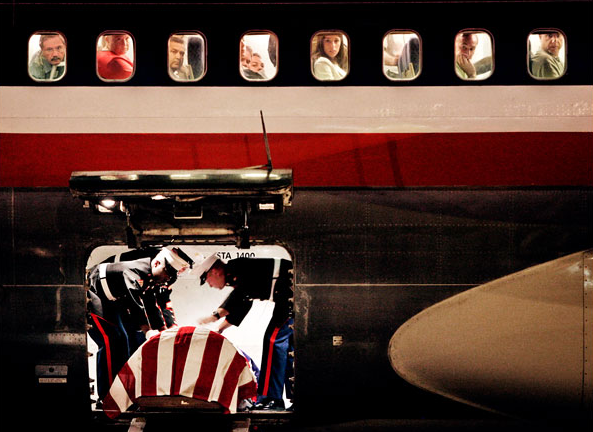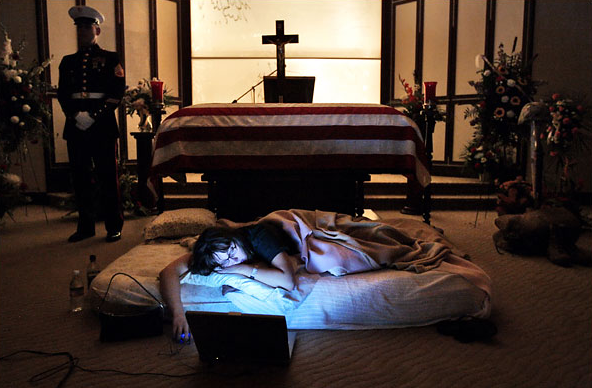The war in Iraq seems to be entering a surreal phase. The surge is working, we are told, and violence is down, and other things are improving, but, of course, the US death toll ticks right along this month at one per day and sectarian bombings continue and none of the avowed political objectives are remotely in sight. Likewise, the likely Democratic victory in November bodes well for a substantial draw-down of our forces, but in the current negotiations with the Iraqi government about our long-term military presence there, the US requested 58 bases, control of the airspace to 30,000 feet, continued immunity from prosecution under Iraqi law of all US personnel and private contractors, and other amenities such as protocols for offensive operations. Given that we currently have 30 bases in Iraq, 58 is an interesting number. And the exemption of roughly 132,000 troops and 154,000 contractors from prosecution for whatever crimes they might commit, well, that is business as usual. “’More than 90 percent of this will be a pretty standard status-of-forces agreement,’ said one senior official involved in drafting the American proposal.”
And that’s the problem: we could be drifting into the usual indifference of Empire. Something called “stability” will be restored while the rest of us will forget that lives were torn apart. So it is that we need to be reminded.
This now famous photo of a coffin being prepared for delivery captures all too well the terrible disconnect between US civilian experience and the costs of this war. The honor guard are doing everything they can to pay proper respect to their fellow Marine, but nothing can change the fact that the dead are consigned to the cargo hold while not far above them the living go about their business. It’s not that those peering out of the windows of the plane are uncaring, but how can they know what is happening in the hold? And unlike the carefully coordinated efforts of the uniformed guard, those above are isolated into individual reality compartments, each firmly separated from the others. The structure of the plane reflects the structure of ordinary life in a liberal society: those things held in common are like baggage, thrown together in the hold, while each of us pursue our separate destinations, free to choose and not likely to even know what is shared.
But, of course, the grief is not shared. The photograph came to my attention again when the New York Times used it to feature a review of the book Final Salute: A Story of Unfinished Lives, by Jim Sheeler, which is based on his Pulitzer Prize winning series in The Rocky Mountain News. The Times slide show accompanying the review documents just how isolated the families of the fallen are in their grief. The honor guards do what they can, but then they leave; after all, they have more work to do.
This photo is one that I find particularly poignant:
Katherine Cathey had asked if she could sleep next to the body of her husband for one last time. Illuminated by the glow of her laptop, she is listening to songs that reminded her of her beloved. She listens if to connect again, somehow, through the ether, through memory. She lies between the hard reality of the shrouded casket and the glow of a virtual world. These are all that remain. She at least knows that. The rest of us sit, like passengers on a plane, unaware of how close we might be to the terrible losses wrought by this war. Or we look into the media portal, like looking out of the window of the plane, staring blankly at the suffering unfolding elsewhere. Like Katherine Cathey, we, too, need to connect.
Photographs by Todd Heisler/Rocky Mountain News. Michael Shaw wrote a fine post on Heisler’s photographs when the Pulitzer was awarded. John and I have written a number of posts on mourning in the US and Iraq, too many to cite here. We’re rather not repeat ourselves, but the war is not over. For some it will never be over. How many are in that category depends on the rest of us.


I also find these two photos very moving. The first one because of the irony that it was printed at all. When this war began photos of flag draped were forbidden in the press and indeed one journalist was fired for including just such a shot. The second picture is sublime, almost as if it were a pieta, and it presents a testimony to the grief of all those left behind. If someone decides to make a memorial for this war they would do well to ponder this photograph.
Thank you for a brilliant website, a noble motivation and particularly for publishing these photos – all of these photos – which are not shown elsewhere (and ought to be shown.) The American people deserve to know what is actually going on in their nation and around the world, and people from around the world deserve a better friend in America. Thank you!
Thank you for posting this. I find these pictures very poignant and moving. These types of pictures should be avaliable to the public because maybe then some others will also stop for a minute in their daily lives and think about what people are going through in this war. I don’t like that we are at war, but I’m so very thankful to those soldiers over there and the ones that come home in the flag draped caskets. They should be remembered by everyone not just their family and friends.